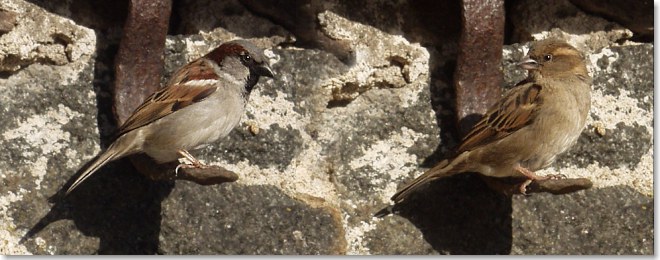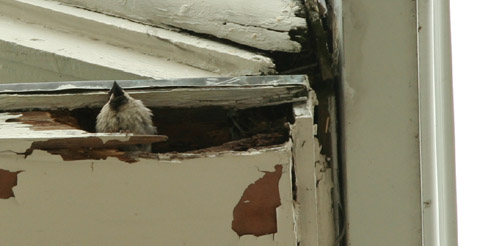Methodology of the 2016 Ipswich Sparrow Survey
run by the Ipswich RSPB Local Group.
The aim of this part of the survey is to see how the sparrow population varies across the town. Simply collecting observations is OK for an indication of presence/absence but will distort the results if we try and compare the density of sparrows in one part of the town with another, because some areas will have more observers than others. So even if the sparrows were uniformly distributed across the town we would get results biased by the distribution of observers.
To standardise things we will survey a sample from each OS National grid square, taking guidance from the WGUS Protocol for censusing urban sparrows. This takes advantage of what we know about sparrows in the breeding season -
Breeding House Sparrows provisioning for young usually travel no further than 70m from nest.

1). The basis of the census is the active nest - males chirping at nest site - or either sex entering a potential nest site either with or without nesting material or food.
2). Timing - April - May - counts ideally conducted within first 2-3 hours after dawn and certainly before midday(when sparrow activity drops markedly). Earlier is better to minimize human disturbances and noise.
3). Census Area - Recommended area 10- 15 ha. Chosen at random from larger areas of urban/suburban areas.
If more resources are available - better to survey more plots rather than increase size of plots.
Plots should be separated by minimum of 50m, it is important not to select on basis of prior knowledge of house sparrow distribution or abundance.
We have divided the town into roughly 50 square kilometres and targeted the 350m x 350m area in the south-western corner of each grid square.
4). types of Urban/Suburban habitat. Should try to make plots as uniform as possible. (i) Town/city centre (ii) Residential suburban (iii) Industrial areas/estates (iv) Rural villages/ small towns.
5). Field Survey Technique - A thorough recce is recommended to map habitat, housing stock, survey route and any inaccessible areas. Categorise housing stock - see table and map gardens and inaccessible areas. A suggested approach is to print off the detailed survey map once you have selected and been allocated a square. Plan the route on the map, if possible without doubling back. If you do have to double back, only count the active nests on the first pass. Mark the nests on the map with a N. Please respect that these are not just sparrow territories but human territories too, looking at roofs with binoculars is not on. Fortunately chirping male sparrows are quite loud and visible at gutter level with the naked eye!

To detect high proportion of nesting attempts - suggest 3 visits with 10- 14 day intervals in between.
Technique walk slowly along all accessible routes.
Make no assumptions about suitability of inaccessible areas for sparrows.
Also recommend mapping all adult males, mark them with an S (as distinct from the nest sites)
Essential to map clear distinctions between individual buildings and gardens, min scale of survey areas 1: 2,500
Do not survey on wet or windy days (wind speed >15 kph = 9.32 mph).
Population density derived from maximum counts of active nests - not means
Takes approx. 2 hours to survey 10- 15 ha of suburban habitat.
Limitations
Most surveys are a trade-off between available effort and ideal sampling. The house sparrow ranges are small, and we are surveying less than a quarter of the available area. In a city with a US style grid pattern there could be sampling artefacts due to the grid, but Ipswich has a fairly organic street pattern so we can get away with a regular grid. We will only pick up variations in density that are larger than about 2km across, but this should give us an indication of whether there are variations in sparrow density across Ipswich. We will not pick up detail of individual sparrow colonies this way, but the results of the survey should show the best parts of the town to target conservation and any follow-up survey effort.